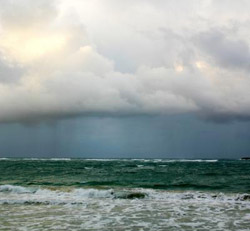Climate change and the South Asian summer monsoon

This shows the approaching monsoon rain.<br>Credit: Gisela E. Speidel, International Pacific Research Center<br>
A review in Nature Climate Change (June 24 online issue) of over 100 recent research articles concludes that with continuing rise in CO2 and global warming, the region can expect generally more rainfall, due to the expected increase in atmospheric moisture, as well as more variability in rainfall.
In spite of the rise in atmospheric CO2 concentration of about 70 parts per million by volume and in global temperatures of about 0.50°C over the last 6 decades, the All India Rainfall index does not yet show the expected increase in rainfall. The reviewers Andrew Turner from the Department of Meteorology at the University of Reading and H. Annamalai from the International Pacific Research Center at the University of Hawaii at Manoa give several reasons for why the region's observed rainfall has not yet increased, among them are inconsistent rainfall observations, decadal variability of the monsoon, the effects of aerosols resulting from industrialization, and land-use changes.
Regional projections for devastating droughts and floods–which are most meaningful for residents living in South Asia– are still beyond the reach of current climate models, according to the reviewers' detailed analyses of the present state of research.
The authors conclude that in order to make regional projections that can help in disaster mitigation and in adapting to climate change, the following is needed: establishing more consistent rainfall datasets by expanding observations to include, for example, agricultural yield; a better grasp of the complicated thermodynamics over the monsoon region and of the interactions among monsoon rainfall, land-use, aerosols, CO2, and other conditions; and an evaluation in coupled circulation models (which allow feedbacks among variables) of those processes that have been shown in simpler models to affect the monsoon and rainfall.
Media Contact
More Information:
http://www.hawaii.eduAll latest news from the category: Earth Sciences
Earth Sciences (also referred to as Geosciences), which deals with basic issues surrounding our planet, plays a vital role in the area of energy and raw materials supply.
Earth Sciences comprises subjects such as geology, geography, geological informatics, paleontology, mineralogy, petrography, crystallography, geophysics, geodesy, glaciology, cartography, photogrammetry, meteorology and seismology, early-warning systems, earthquake research and polar research.
Newest articles

Bringing bio-inspired robots to life
Nebraska researcher Eric Markvicka gets NSF CAREER Award to pursue manufacture of novel materials for soft robotics and stretchable electronics. Engineers are increasingly eager to develop robots that mimic the…

Bella moths use poison to attract mates
Scientists are closer to finding out how. Pyrrolizidine alkaloids are as bitter and toxic as they are hard to pronounce. They’re produced by several different types of plants and are…

AI tool creates ‘synthetic’ images of cells
…for enhanced microscopy analysis. Observing individual cells through microscopes can reveal a range of important cell biological phenomena that frequently play a role in human diseases, but the process of…





















